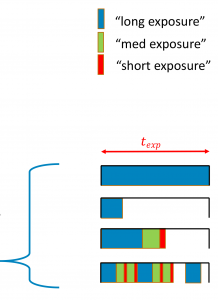
High-frequency flickering light sources such as pulse-width modulated LEDs can cause image sensors to record incorrect levels. We describe a model with a loose set of assumptions (encompassing multi-exposure HDR schemes) which can be used to define the Flicker Signal, a continuous function of time based on the phase relationship between the light source and exposure window. Analysis of the shape of this signal yields a characterization of the camera’s response to a flickering light source–typically seen as an undesirable susceptibility–under a given set of parameters. Flicker Signal calculations are made on discrete samplings measured from image data. Sampling the signal is difficult, however, because it is a function of many parameters, including properties of the light source (frequency, duty cycle, intensity) and properties of the imaging system (exposure scheme, frame rate, row readout time). Moreover, there are degenerate scenarios where sufficient sampling is difficult to obtain. We present a computational approach for determining the evidence (region of interest, duration of test video) necessary to get coverage of this signal sufficient for characterization from a practical test lab setup.
Author: Robert Sumner, Lead Engineer, Imaging Science
Presented at Electronic Imaging 2020

